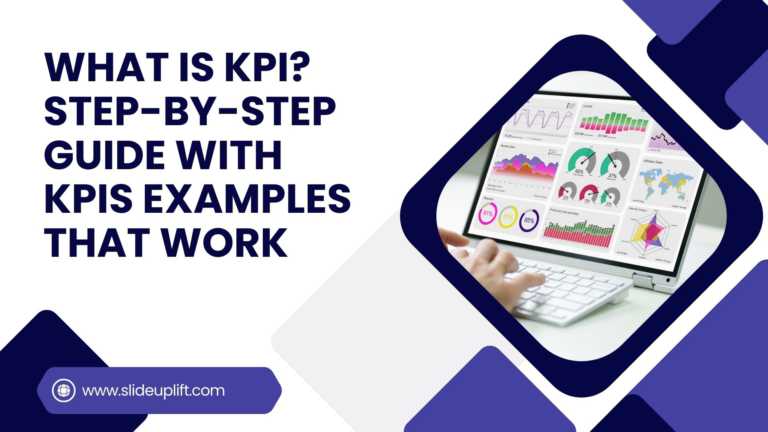How To Write A Project Proposal Presentation?
Presenting your ideas well is essential to gaining quick approval for projects, whether internal or external. Even the strongest elevator pitch is not going to work by itself. Writing a project proposal presentation enters the picture at this point. You must be able to deliver a proposal for a project effectively if you have the technology or product to show a particular investor. This blog will help you understand how to write a project proposal presentation quickly and how to compose it.
What is a Project Proposal Presentation?
A project proposal serves as a project management tool for outlining the goals and specifications of a project. It facilitates initial project planning framework agreement between organizations and external project stakeholders.
Its primary goal is to win over decision-makers. Because of this, a project proposal presents the main selling point of your endeavor to internal and external project stakeholders. The proposal aims to catch the interest of project sponsors and stakeholders.
Different Types of Project Proposal Presentations
Before learning how to make a project proposal presentation, you need to know that they are of different types. Here are some of the types in which you can give a presentation of a project proposal:

1. Solicited Project Proposal:
A solicited project proposal is a formal document submitted in response to a specific request or invitation from an organization or entity seeking external project ideas or services. The one requesting issues a Request for Proposal (RFP).
The proponents create a solicited project proposal presentation detailing their approach, expertise, timelines, and costs for addressing the outlined needs. Organizations evaluate and compare the proposals that describe their solutions and services before selecting them.
2. Unsolicited Project Proposal
In an unsolicited proposal, you create a proposal after carefully identifying the possible solutions for the problems. It’s unlike an RFP but something an investor didn’t ask for. These project proposal presentations are sent to potential clients without being asked for as a pitch or an introduction to investors or sponsors.
3. Informal Project Proposal
With informal project proposals, potential customers express interest in your offerings and ask to review your proposal. Since these are based on conversations rather than official requests, they frequently include all the required information. So they usually need much more research.
4. Renewal Project Proposal
A renewal project proposal presentation is a document that outlines plans for extending, updating, or continuing an existing project or service. These offers are made to potential customers to prolong the support for an ongoing project close to completion. The proposal typically includes reviewing the project’s past performance, achievements, and any necessary adjustments or enhancements for the renewal period.
5. Continuation Project Proposal
A continuation project proposal is a document submitted to request for extension or continuation of an existing project beyond its initially planned time frame. It typically includes an assessment of the project’s progress, achievements, and the need for additional time to accomplish its goals. The proposal outlines the reasons for the extension, any adjustments to the project plan, and a renewed timeline to ensure the successful completion of the ongoing initiative.
6. Supplemental Project Proposal
A supplemental project proposal presentation is a formal request document submitted to propose additional work or modifications to an existing project. The use of this proposal arises due to changing project requirements, unforeseen challenges, or the identification of new opportunities during the project. The proposal details the scope of the supplemental work, its impact on the overall project, associated costs, and any adjustments needed in the project plan.
How To Write A Project Proposal Presentation?
This section gives you some clarity on how to write a project proposal PowerPoint presentation. It outlines the blueprint of a comprehensive presentation, using a project proposal presentation example:

1. Understand Your Audience and the Problem you’re Solving:
Before diving into the content creation process, it’s essential to have a deep understanding of your audience. Identify their needs, concerns, and expectations to tailor your project proposal presentation accordingly. This ensures that your proposal addresses their specific requirements and resonates with them.
Persuade your reader with references and data. Among the inquiries to make are:
- What issue is your project trying to solve?
- What is known about this issue already?
- Who has previously tackled this issue, and what literature is available?
- Why can’t this problem be adequately addressed by previous research?
2. Define Clear Objectives:
Clearly outline the objectives of your project proposal presentation on PowerPoint or Google Slides. Whether seeking approval, securing funding, or gaining support, having well-defined goals will guide your content creation process and help you focus on delivering a persuasive message.
A few things to mention are:
- Your project’s mission statement
- Your project timeline, complete with significant checkpoints
- Roles and duties of the project team
- A risk register outlining your risk-reduction strategy
- Deliverables for the project
- Tools for reporting that you’ll utilize during the project
3. Structure Your Presentation:
Create a well-organized structure for your presentation to maintain clarity and flow. Begin with an engaging introduction, followed by a detailed overview of the project, the problem it aims to solve, proposed solutions, and a compelling conclusion. Use visual aids, such as slides and graphics, to enhance understanding and engagement.
As you’re defining the structure of your presentation, be sure to incorporate the following:
- The outcome or goal of your undertaking
- A schedule for the project’s deliverables’ readiness
- SMART objectives in line with the outputs you’re generating

4. Craft a Captivating Introduction:
Start your project proposal presentation with a hook that captures attention and sets the tone for the rest of the proposal. Clearly state the problem your project addresses and why it’s important. Establish a connection with your audience by highlighting the project’s relevance to their interests or goals.
5. Clearly Define The Project Scope:
Provide a comprehensive overview of your project, detailing its scope, objectives, and anticipated outcomes. Clearly articulate the timeline, milestones, and deliverables to give your audience a realistic understanding of what to expect.
6. Highlight The Value Proposition:
Emphasize the unique selling points and benefits of your project. Communicate how it addresses the identified problem and why it stands out from alternative solutions. Use data, testimonials, or case studies to bolster your claims and build credibility.
7. Develop A Realistic Budget:
Include a detailed budget that outlines the financial requirements of your project. Break down costs into categories and provide justifications for each expense. This demonstrates a thorough understanding of the financial implications and reinforces your credibility.
8. Address Potential Challenges And Risks:
Acknowledge potential challenges and risks associated with the project and outline mitigation strategies. Demonstrating a proactive approach to risk management reflects your preparedness and commitment to the project’s success.
9. Engage Your Audience:
Encourage audience interaction throughout your presentation. Incorporate opportunities for questions and discussions to address concerns, gather feedback, and foster a collaborative atmosphere.
10. Conclude with a Strong Call to Action:
Wrap up your presentation with a compelling conclusion reinforcing the project’s value and importance. Clearly state the desired action or decision you seek from your audience, whether it’s approval, support, or funding.
By following these comprehensive steps, you can create a project proposal presentation that informs and persuades, increasing the likelihood of successful project approval and implementation.

How To Present A Project Proposal Presentation?

Presenting a project proposal is an art that involves not just the spoken word but also the visual representation of your ideas. Each slide in your presentation plays a crucial role in conveying key information and building a compelling case for your project:
Slide 1: Title Slide
The title slide sets the tone for your presentation. Include the project title, your name or team name, and the date. Use visually appealing graphics or images related to the project to capture attention.
Slide 2: Agenda
Provide an overview of the presentation structure. This helps orient your audience and gives them a roadmap of what to expect. Clearly outline the key topics and sections you’ll be covering.
Slide 3: Introduction
Start with a compelling introduction. Highlight the problem your project addresses and why it is significant. Engage your audience initially, making them eager to learn more about your proposal.
Slide 4: Project Overview
Offer a brief but comprehensive overview of the project. Include key details such as the project’s purpose, goals, and objectives. Use visuals like charts or graphics to convey information succinctly.
Slides 5-8: Problem Statement and Need
Dedicate a few slides to articulate clearly the problem your project aims to solve. Provide data, statistics, or real-life examples to emphasize the urgency and relevance of the issue.
Slide 9: Solution
Present your proposed solution to the identified problem. Break it into key components and use visuals to illustrate how your project addresses the issues. Communicate the unique value of your solution.
Slides 10-12: Project Scope and Deliverables
Detail the scope of your project, including specific deliverables and milestones. Use visuals like timelines or Gantt charts to help your audience visualize the project’s timeline and workflow.
Slide 13: Budget
Introduce the financial aspect of your project. Break down the project budget into categories and provide a clear overview of the costs associated with each. Use graphs or pie charts to make the information easily digestible.
Slides 14-15: Risks and Mitigation
Acknowledge potential challenges and risks associated with your project. Demonstrate your awareness and preparedness by outlining mitigation strategies for each identified risk.
Slide 16: Team and Expertise
Introduce the key members of your project team and highlight their relevant expertise. This slide helps build credibility and assures your audience that you have the necessary skills to execute the project successfully.
Slide 17: Conclusion and Call to Action
Wrap up your presentation with a powerful conclusion. Reiterate the key points, emphasize the project’s value, and issue a clear call to action, whether it’s approval, support, or further discussion.
Tips On Giving A Project Proposal Presentation
Regardless of the type of presentation you deliver, your goal is to influence or wow the audience:
Define Your Agenda:
- Clarify proposal details for investors and clients.
- Address omitted RFP questions.
- Contrast your plan with rivals if requested.
Tell a Story:
- Introduce data, charts, and graphs with a narrative.
- Engage the audience by appealing to human nature.
- Enhance content through storytelling.
Think Lean:
- Apply lean thinking to enhance client relationships.
- Eliminate non-beneficial procedures in your presentation.
- Avoid jumping to long-term future estimates.
Construct an Eye-Catching Presentation:
- First, dress appropriately for the presentation you are about to give.
- A well-constructed presentation reflects positively on your company.
- Avoid hastily put-together presentations to maintain quality perception.
Ask Questions:
- Avoid excessive talking during the presentation.
- Engage the audience by posing questions.
- Boost your confidence and gather feedback through polls or direct inquiries.
ALSO READ: How to write an effective project charter?
Top 5 Project Proposal Templates
1. Project Proposal Summary PowerPoint Template

This template provides a concise and visually appealing overview of your project proposal, featuring key elements such as objectives, timelines, and budgetary considerations in a structured and professional format.
2. Project Proposal Presentation Template

The Project Proposal Presentation Template is designed for project leaders to propose new ideas to clients, investors, or business owners. Executives can also use it to propose their businesses to different investors. The marketing, product, and project management teams can use this presentation to propose new business or project ideas.
3. Project Management Lifecycle PowerPoint Template

Specifically designed to illustrate the phases and milestones of project management, this template guides stakeholders through the entire project lifecycle, emphasizing key stages, deliverables, and decision points for a comprehensive understanding.
4. Project Management Swimlane PowerPoint Template

This template employs a swimlane format to delineate responsibilities among team members or departments, offering a clear and organized visualization of tasks and workflows to enhance transparency and streamline project execution.
5. Business Proposal Deck PowerPoint Template

A sophisticated and customizable template for crafting compelling business proposals, this deck incorporates modern design elements to showcase essential details, including market analysis, value propositions, and financial projections, ensuring a professional and persuasive presentation.
Conclusion
Developing a project proposal is essential for connecting you, your group or organization, investors, and other stakeholders. Your greatest option for a concise, educational, and polished presentation is a project proposal presentation. As discussed above, making an eye-catching summary of your project will attract more interested outside collaborators and their encouraging comments.
You can also access SlideUpLift, one of the top platforms for presentation templates and tools to help with the presentation-making task. You can select from a wide range of carefully crafted templates for project proposals. SlideUpLift gives presenters the tools to make visually striking and memorable presentations, emphasizing customization, clarity, and aesthetics.
FAQs
-
How do I make a project proposal PowerPoint presentation?
To create a project proposal PowerPoint presentation, start by outlining the project’s goals, objectives, and key details. Utilize SlideUpLift’s Project Proposal templates for a professional look and incorporate visuals for clarity.
-
What is the step-by-step process for the presentation of a project proposal?
During the project proposal presentation, the presenter should introduce the project, present an overview, detail the methodology, present the timeline and budget, and conclude with a summary of key points.
-
What should I include in the presentation of a project proposal?
In a project proposal presentation, you should cover essential elements such as project goals, methodology, budget, and team details to provide a comprehensive overview for stakeholders.
-
How should I start a project proposal presentation?
Begin your project proposal presentation with a strong opening, clearly introducing the project’s name and purpose and highlighting its significance to capture the audience’s attention.
-
Where to find the best Project Proposal Presentation templates?
There are a variety of project proposal presentation templates available on SlideUpLift. Just find your desired template on SlideUpLift.com and download it.














